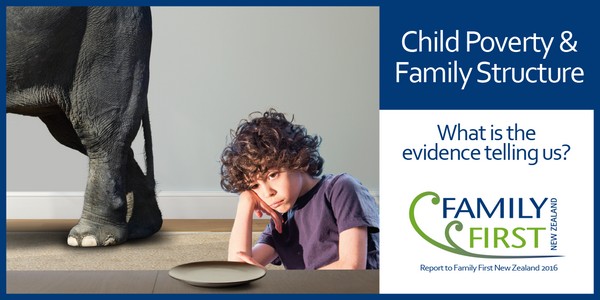‘Hot Air’ on Child Poverty Ignores ‘Elephant in Room’
 Media Release 5 October 2016
Media Release 5 October 2016
Family First says that the current ‘noise’ by politicians and the Children’s Commissioner around child poverty and ‘targets’ will simply be hot air and rhetoric doomed to failure until the ‘elephant in the room’ of family structure is acknowledged and tackled.
“Family malformation and breakdown is contributing significantly to increasing income inequality and child poverty and must be confronted before we will see any significant improvements. NZ’s rapidly changing family structure has contributed significantly to increasing income inequality,” says Bob McCoskrie, National Director of Family First NZ.
The comments are made on the back of research which Family First commissioned and published in June. The report by prominent welfare commentator and researcher Lindsay Mitchell entitled “CHILD POVERTY & FAMILY STRUCTURE: What is the evidence telling us?” examined household incomes and family structure from the early 1960s through to current day, and said that while unemployment, low wages, high housing costs and insufficient social security benefits are consistently blamed for child poverty, a major culprit – if not the major culprit – is family malformation, that is, a lack of two married committed parents.
“The correlation between family structure and child poverty is significantly stronger than the correlation between child poverty and other factors such as unemployment, high housing costs and low wages or benefits,” says Mr McCoskrie.
Evidence produced in the report highlights:
- Despite families being much smaller, parents being older, mothers being better educated and having much higher employment rates, child poverty has risen significantly since the 1960s.
- In 1961, 95 percent of children were born to married couples; by 2015 the proportion had fallen to 53 percent. For Maori, 72 percent of births were to married parents in 1968; by 2015 the proportion had fallen to just 21 percent.
- In 2015, 27 percent of registered births were to cohabiting parents. But the risk of parental separation by the time the child is aged five is, however, 4-6 times greater than for married parents.
- Single parent families make up 28 percent of all families with dependent children. These families are the poorest in New Zealand.
- 51% of children in poverty live in single parent families.
- Single parents have the lowest home ownership rates and the highest debt ratios.“As stated in the report, despite marriage being the best protector against child poverty, it has become politically unfashionable – some argue insensitive – to express such a view,” says Mr McCoskrie.“Until we state the truth, we won’t solve the problem.”
READ the Full Report
READ the Executive Summary
ENDS






